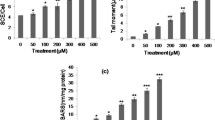The effect of usnic acid enantiomers on the genotoxic effects of dioxidine and methyl methanesulfonate was studied in vitro in human peripheral blood lymphocytes by the DNA comet method. We found that usnic acid enantiomers in a concentration range of 0.01-1.00 μM demonstrated pronounced antigenotoxic activity and reduced DNA damage induced by genotoxicants by 37-70%. In the same concentration range, the test enantiomers reduced the level of atypical DNA comets (hedgehogs) induced by genotoxicants by 23-61%. The test compounds did not modulate the effects of genotoxicants in a concentration of 10 μM and potentiated them in a concentration of 100 μM. The modifying activity of usnic acid did not depend on spatial configuration and on the used model genotoxicant.
Similar content being viewed by others
References
Zhanataev AK, Anisina EA, Chayka ZV, Miroshkina IA, Durnev AD. The phenomenon of atypical DNA comets. Cell Tissue Biol. 2017;11(4):286-292.
Zhanataev AK, Nikitina VA, Voronina ES, Durnev AD. Methodological aspects of assaying DNA damage by the DNA comet technique. Prikladnaya Toksikologiya. 2011;2(4):27-37. Russian.
Prokopiev IA, Filippov EV, Filippova GV, Gladkina NP. Genotoxicity of usnic-acid enantiomers in vitro in human peripheralblood lymphocytes. Cell and Tissue Biology. 2017;11(2):141-146.
Abo-Khatwa AN, al-Robai AA, al-Jawhari DA. Lichen acids as ncouplers of oxidative phosphorylation of mouse-liver mitochondria. Nat. Toxins. 1996;4(2):96-102.
Caldeira da Silva CC, Cerqueira FM, Barbosa LF, Medeiros MH, Kowaltowski AJ. Mild mitochondrial uncoupling in mice affects energy metabolism, redox balance and longevity. Aging Cell. 2008;7(4):552-560.
Guo L, Shi Q, Fang JL, Mei N, Ali AA, Lewis SM, Leakey JE, Frankos VH. Review of usnic acid and Usnea barbata toxicity. J. Environ. Sci. Health C Environ. Carcinog. Ecotoxicol. Rev. 2008;26(4):317-338.
Han D, Matsumaru K, Rettori D, Kaplowitz N. Usnic acidinduced necrosis of cultured mouse hepatocytes: inhibition of mitochondrial function and oxidative stress. Biochem. Pharmacol. 2004;67(3):439-451.
Joseph A, Lee T, Moland CL, Branham WS, Fuscoe JC, Leakey JE, Allaben WT, Lewis SM, Ali AA, Desai VG. Effect of (+)-usnic acid on mitochondrial functions as measured by mitochondria-specific oligonucleotide microarray in liver of B6C3F1 mice. Mitochondrion. 2009;9(2):149-158.
Kitanovic A, Walther T, Loret MO, Holzwarth J, Kitanovic I, Bonowski F, Van Bui N, Francois JM, Wölfl S. Metabolic response to MMS-mediated DNA damage in Saccharomyces cerevisiae is dependent on the glucose concentration in the medium. FEMS Yeast Res. 2009;9(4):535-551.
Kohlhardt-Floehr C, Boehm F, Troppens S, Lademann J, Truscott TG. Prooxidant and antioxidant behaviour of usnic acid from lichens under UVB-light irradiation — studies on human cells. J. Photochem. Photobiol. B. 2010;101(1):97-102.
Koparal AT, Tüylü BA, Türk H. In vitro cytotoxic activities of (+)-usnic acid and (-)-usnic acid on V79, A549, and human lymphocyte cells and their non-genotoxicity on human lymphocytes. Nat. Prod. Res. 2006;20(14):1300-1307.
Korshunov SS, Skulachev VP, Starkov AA. High protonic potential actuates a mechanism of production of reactive oxygen species in mitochondria. FEBS Lett. 1997;416(1):15-18.
Leandro LF, Munari CC, Sato VL, Alves JM, de Oliveira PF, Mastrocola DF, Martins Sde P, Moraes Tda S, de Oliveira AI, Tozatti MG, Cunha WR, Tavares DC. Assessment of the genotoxicity and antigenotoxicity of (+)-usnic acid in V79 cells and Swiss mice by the micronucleus and comet assays. Mutat. Res. 2013;753(2):101-106.
Luzina OA, Salakhutdinov NF. Biological activity of usnic acid and its derivatives: Part 1. Activity against unicellular organisms. Russ. J. Bioorg. Chem. 2016;42(2):115-132.
Procházková D, Boušová I, Wilhelmová N. Antioxidant and prooxidant properties of flavonoids. Fitoterapia. 2011; 82(4):513-523.
Author information
Authors and Affiliations
Corresponding author
Additional information
Translated from Byulleten’ Eksperimental’noi Biologii i Meditsiny, Vol. 164, No. 9, pp. 289-293, September, 2017
Rights and permissions
About this article
Cite this article
Prokop’ev, I.A., Filippov, E.V., Filippova, G.V. et al. Pro/Antigenotoxic Activity of Usnic Acid Enantiomers In Vitro. Bull Exp Biol Med 164, 312–315 (2018). https://doi.org/10.1007/s10517-018-3979-z
Received:
Published:
Issue Date:
DOI: https://doi.org/10.1007/s10517-018-3979-z




